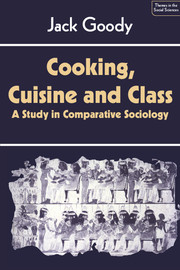Book contents
- Frontmatter
- Contents
- List of illustrations
- Preface
- Dedication
- 1 Intentions and remarks
- 2 State of play
- 3 Production and consumption among the LoDagaa and Gonja of northern Ghana
- 4 The high and the low: culinary culture in Asia and Europe
- 5 Industrial food: towards the development of a world cuisine
- 6 The impact of the world system
- 7 Cooking and the domestic economy
- Appendix: Terms, operations and cognition
- Notes to the text
- Bibliography
- Index
- BY THE SAME AUTHOR
4 - The high and the low: culinary culture in Asia and Europe
Published online by Cambridge University Press: 05 June 2012
- Frontmatter
- Contents
- List of illustrations
- Preface
- Dedication
- 1 Intentions and remarks
- 2 State of play
- 3 Production and consumption among the LoDagaa and Gonja of northern Ghana
- 4 The high and the low: culinary culture in Asia and Europe
- 5 Industrial food: towards the development of a world cuisine
- 6 The impact of the world system
- 7 Cooking and the domestic economy
- Appendix: Terms, operations and cognition
- Notes to the text
- Bibliography
- Index
- BY THE SAME AUTHOR
Summary
In the traditional societies of northern Ghana there was little internal difference in the food, whether raw or cooked, of the various members. Even a state like Gonja that consisted of distinct strata organised in a hierarchy and differentiated in terms of access to political office, socio-economic role and religious affiliation, had a simple cuisine. There is little evidence of differentiation in the accounts of pre-colonial travellers or early administrators, and it is significant that visitors of high status, not only Europeans, were often offered food in its raw rather than its cooked state.
The provision of food for strangers was usually the responsibility of the local chief or headman. However in urban centres where merchants gathered, the landlord would provide cooked food for his ‘strangers’. When Binger visited the Gonja town of Salaga in 1888, he found the compound of his host had a cooking pot and a stirring stick fixed on the roof as a sign of the hospitality that this well-to-do merchant was prepared to offer (Binger 1892: ii, 85).
The situation is not very different today, although the impact of a new type of stratification that results most immediately from literacy and education and is associated with teaching, administration, military rank and political office, is having its effect, more especially now that new forms of primary production, the tractor cultivation of high-yielding varieties of rice for the market, have made their mark on the savannah area (Goody 1981).
- Type
- Chapter
- Information
- Cooking, Cuisine and ClassA Study in Comparative Sociology, pp. 97 - 153Publisher: Cambridge University PressPrint publication year: 1982



